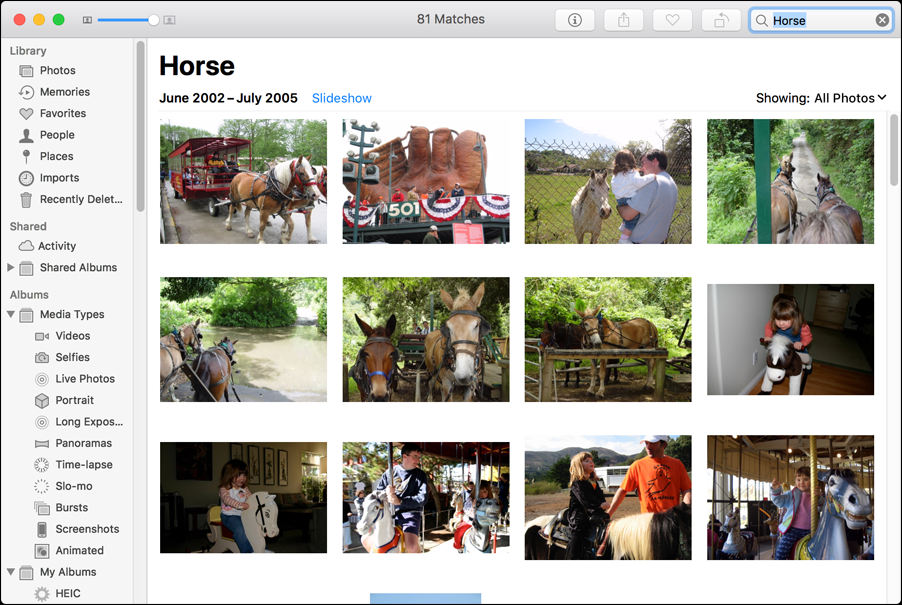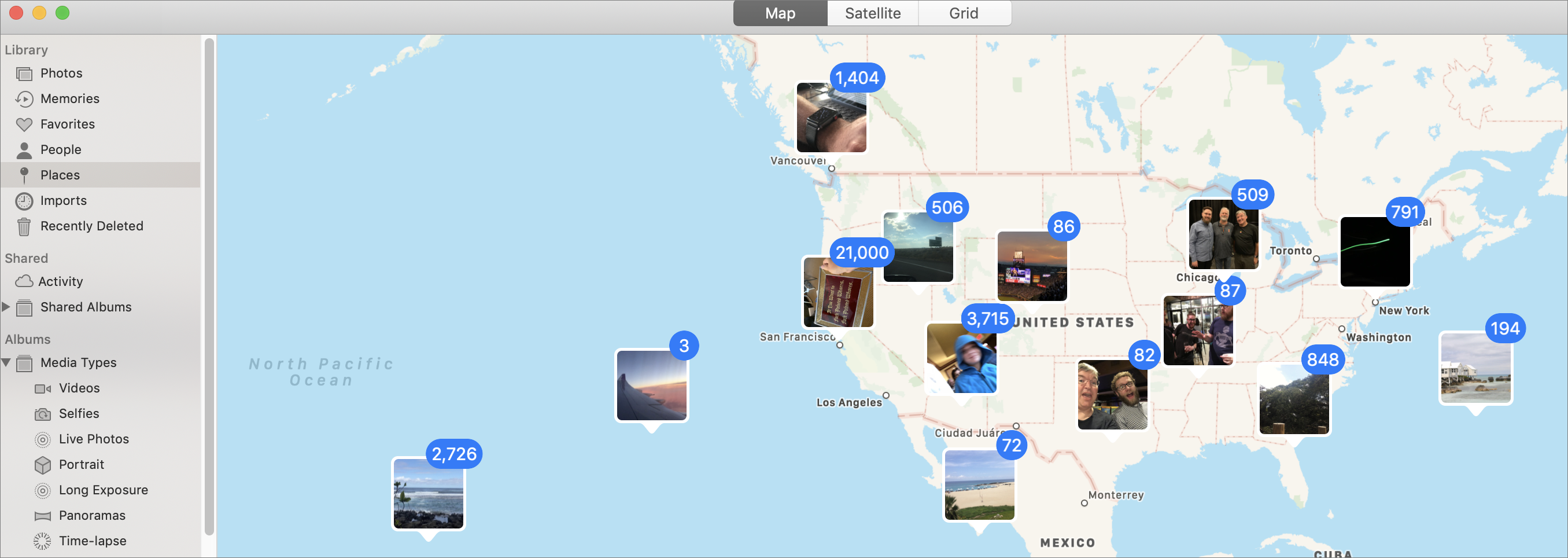Use Search to Find Your Photos
All the images in your Photos libraries are scanned millions of times with machine-learning algorithms to identify faces, as well as more than 4,000 different scenes or objects (see Find and Name People for more on face-detection). This makes the Search feature in Photos incredibly powerful. Want to find a photo featuring a dog? Just type dog in the search box. The automatically generated Dog category will provide you with possibilities (Figure 41). And that’s just the beginning.

The Search Box Is Your Friend
Some people use search boxes habitually. Others see them as a last resort. If you’re in the latter camp, you need to break from tradition when you use Photos. The Search feature in Photos is terrific. You can quickly search keywords (Figure 42), titles, or descriptions. Enter a year, or a month and a year, and you see all the photos taken during that time.

I rely on the Search feature for navigating my library of more than 70,000 photos, and I highly recommend it. When in doubt, use the search box!
On the Mac, if you don’t see the search box in the upper-right corner, back out to a broader viewing level, such as the main level of an album.
In iOS, if you don’t see the search box, make sure you are in the main level of Photos, Memories, or Albums and tap the Search icon.
Experience Rich Search Results in iOS
In iOS 12, Photos takes a step forward when compared to macOS Mojave. Search results on iOS are incredibly rich. When you search for something, you won’t just find the photos that match, but you’ll also see all the Moments and Albums that contain matching photos.
The real power, though—and the place where iOS 12 really has it on macOS—is the capability to combine search terms. If you want to search for a dog, you can type in dog—and you’ll see all the photos that Apple’s machine-learning technology has identified as containing dogs. But on that search-results screen you’ll also see a bunch of suggestions for related items that are often found with dogs—people, locations, even years or seasons. If you tap on one of these items, they’ll be added to your search query, so now you’ll see all instances of, for example, a particular person and a dog (Figure 43).

Use Siri to Search for Photos
On both iOS and macOS, you can use Siri to search through your photos. Just say something like “Show me pictures of dogs” or “Show me photos taken in Hawaii” or “Show me pictures from 2013” and Siri will open Photos and create a special view displaying the results of your search. The results aren’t always perfect, of course, but you’ll be surprised by how easy and natural it feels to say “Show pictures taken in Rhode Island this year.”
Harness the Power of Categories
Apple’s deep image analysis recognizes more than 4,000 different objects and scenes, from alleys to zebras (Figure 44). It’s not perfect, but it’s pretty amazing. (I didn’t even think I had pictures of zebras in my Photos library, but I do!) Today’s iOS devices are so fast they can do this processing as you take photos, but if you’re importing a huge batch of photos onto a Mac or upgrading your entire library, you’ll need to be patient and let it churn for a while.

Once an image has been scanned, that information is available as a new Category—essentially an invisible keyword assigned by Photos. Unfortunately, categories appear only in the search box—they’re not viewable via the Info window, and you can’t build a smart album based on them. You can’t even search for two categories at once! Still, they’re incredibly powerful at adding a layer of structure over your photos.
Search by Categories
To use categories, type a term in the search box and see what comes up. Choose a result labeled Category (Figure 45). It’s a bit like a Google search—you’ll get good results and bad results—but add your own judgment and you can probably find what you’re seeking.

Search by Multiple Categories
As mentioned earlier in this chapter, on iOS you can search on multiple categories or combine a category search with people or locations. After you search for one category, just type in another search term and select it, and Photos will show you all photos that match both terms.
When I searched my photo library for dog, I found 729 photos. Adding the category snow dropped the total number of photos to just two—and both of them were pictures of my dog in the snow (Figure 46).

This is incredibly powerful. If you want to find photos with specific combinations of people, places, or actions, you can do it in seconds. I searched for my son by name and then added the second search term swimming and instantly found 57 photos. Ten years of pool parties, found in just moments.
Turn Categories into Keywords
If you want to do more with a category than Apple can deliver—for example, to find horses on a beach—turn the category into a keyword: working on the Mac, select the images within a Category search result (such as beach), choose Window > Info, and apply an appropriate keyword.
You can then use a smart album to combine multiple categories by including the new keywords you created.
Find Photos by Location
You can use Photos to view your entire library on a map (assuming the images have geolocation data attached—if not, see Add Geolocation Data, nearby.)
Take a Tour
To see all your photos on the map, click Places in the Library section of the sidebar (on iOS, Places is in the Albums tab). The resulting map displays square image previews along with numbers to indicate how many photos have been taken in each location (Figure 47).

As you zoom in by clicking the plus/minus buttons, spreading your fingers on a trackpad, or double clicking, the squares divide, offering a more detailed view of locations. These can be remarkably detailed; I was able to zoom in and see the various locations I took photos during a beach walk we took in Hawaii (Figure 48).

To see all the photos taken at a given location, just click or tap the square.
Search for a Location
If you’re not a fan of zipping around on a map looking for photos, you can also use the search box to find your images by location. Search for the names of cities, counties, states, countries, and even nearby landmarks.
I love using search in Photos to find all the images taken in a location. When I type AT&T Park, for example, I am given the option of displaying all the pictures I’ve taken at the place where the San Francisco Giants play.
